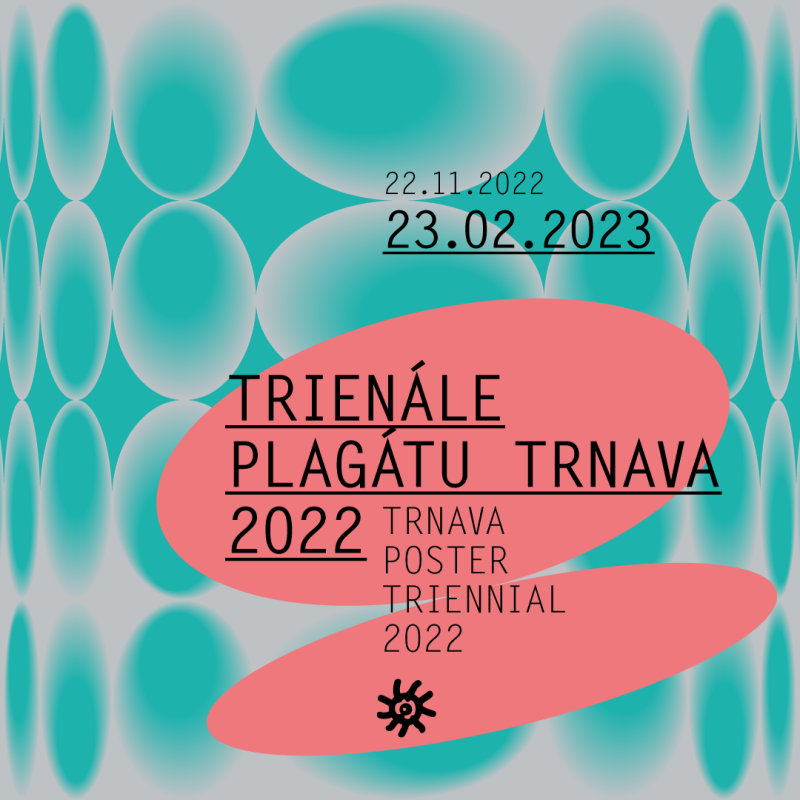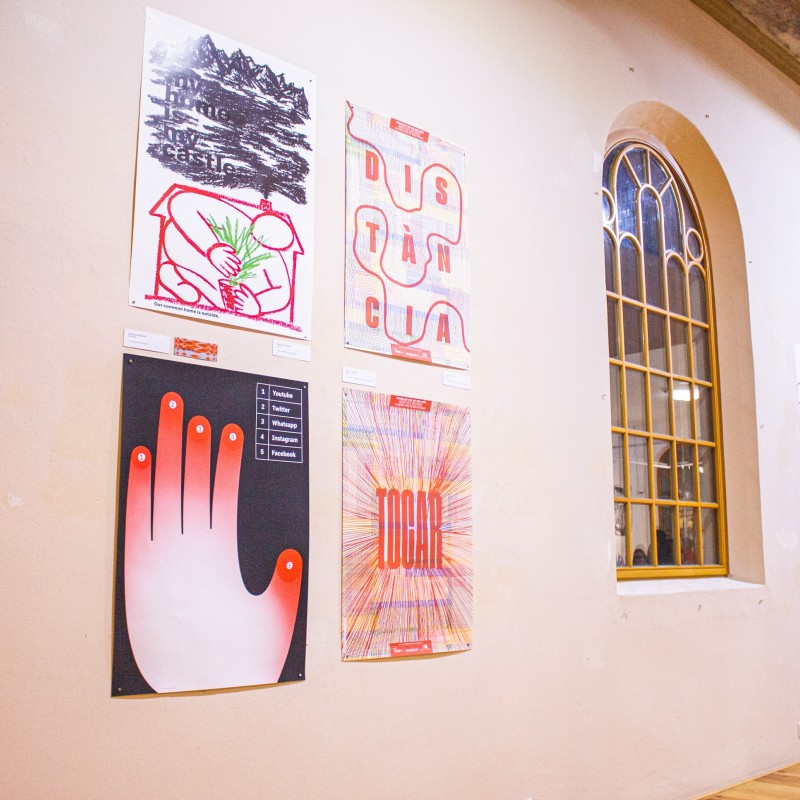Trienále plagátu Trnava 2022 - Kategória B (študenti) a C (kontakt)
Gabriela Ondrišáková | Silvia Kružliaková | kurátor výstavy
22.11.2022 - 23.02.2023
Galéria Jána Koniarka v Trnave, Synagóga – Centrum súčasného umenia, Halenárska 2, Trnava
Plagát má aj v súčasnosti schopnosť poukázať na aktuálne závažné problémy, ktoré rezonujú lokálne aj globálne. Hoci médium plagátu sa dnes vo svojej kla sickej podobe objavuje už len zriedkavo, neznamená to, že by upadalo a grafickí dizajnéri oň strácali záujem. Práve naopak, stáva sa exkluzívnejším a mnohí dizajnéri a výtvarníci po celom svete sú ním stále fascinovaní. Často im totiž dáva omnoho viac výtvarnej slobody v porovnaní s inými zákazkami a možnosť vyjadriť svoj postoj.
Dokazujú to aj prihlásené plagáty autorov z celého sveta do XI. ročníka Trienále plagátu Trnava 2022. Mnohí grafickí dizajnéri prostredníctvom environmentálneho plagátu dvíhajú varovný prst pred klimatickou krízou, plytvaním a drancovaním prírodných zdrojov, nadmerným konzumom a úhynom živočíšnych aj rastlinných druhov. Pálčivými témami (ktoré čiastočne vychádzajú práve z klimatickej krízy) sú tiež chudoba, vojny a diktatúry. Grafickí dizajnéri tiež veľmi často vo svojich plagátoch riešia fenomén sociálnych sietí. Poukazujú na to, že v súčasnosti mnohým ľuďom nahrádzajú prirodzenú komunikáciu a poskytujú im možnosť vystupovať pod inou identitou. Upozorňujú aj na šírenie dezinformácií a fake news (nielen) na týchto platformách. Plagát je tiež vďačným médiom pre kultúrny sektor aj v tohtoročnom výbere sa často objavujú plagáty pre divadlá, filmy, výstavy, prehliadky dizajnu, festivaly či koncerty.
Medzi tie najlepšie postúpili plagáty z krajín Európy, Ázie, Ameriky a Afriky, konkrétne Slovensko, Česko, Rakúsko, Poľsko, Maďarsko, Bulharsko, Rumunsko, Srbsko, Chorvátsko, Bosna a Hercegovina, Slovinsko, Ukrajina, Estónsko, Švédsko, Veľká Británia, Francúzsko, Nemecko, Švajčiarsko, Taliansko, Španielsko, Portugalsko, Turecko, USA, Argentína, Brazília, Ekvádor, Mexiko, Kostarika, Nikaragua, Kuba, Čína, Japonsko, Južná Kórea, Taiwan, Malajzia, Irán a Egypt. Veľká časť z nich je aj fyzicky prezentovaná na výstavách Trienále plagátu Trnava 2022 v Trnave.
Väčšina plagátov je vytvorená digitálne, ale nájdu sa aj výnimky vytvorené ručne klasickými výtvarnými technikami. Každý prihlásený autor má svoj jedinečný výtvarný štýl a rukopis, vo výbere plagátov však určite dominuje minimalizmus a očistenie od všetkých nadbytočností. Prevláda digitálna, resp. digitalizovaná kresba, práca s linkou alebo čisté farebné plochy (fotografické reprodukcie sa objavujú len zriedkavo) a pre mnohých autorov je písmo obľúbeným výrazovým prostriedkom, s ktorým radi experimentujú.
Popri základných kategóriách Profesionál a Študent sme v TPT 2022 navrhli aj špecifickú kurátorskú kategóriu na tému „kontakt“. Kontakt je jedna z najzákladnejších a najprirodzenejších ľudských potrieb. Človek sa ako spoločenský tvor potrebuje neustále s druhými ľuďmi „spájať“ – komunikovať. Je to nielen otázka prežitia, ale hlavne pilier duševného zdravia jednotlivca. V súčasnom svete sa však zmysluplná konverzácia aj fyzický kontakt často redukujú na minimum, prenášajú sa do online sveta alebo úplne absentujú. V dôsledku toho čoraz viac ľudí v stále mladšom veku trpí osamelosťou, depresiami a úzkosťami. Svetová pandémia ochorenia COVID-19 a s ňou spojená sociálna izolácia tieto problémy už len umocnili. Poukázali na to aj autori plagátov zaslaných do tejto kategórie. Na ich návrhoch sa objavuje napríklad mobilný telefón ako symbol straty fyzického kontaktu, náznaky domácej izolácie, v ktorej sa ľudstvo nechtiac ocitlo, ako aj ruky či postavy naznačujúce túžbu po medziľudskej blízkosti. Kurátorským zámerom je pripomenúť si dôležitosť fyzických stretnutí, rozhovorov, zdieľania pocitov a myšlienok. Budeme sa tešiť, ak si spoločne pozrieme súčasnú svetovú plagátovú tvorbu!
The poster still has the ability to point out current serious matters that resonate locally and globally. Although the medium of the poster rarely appears today in its classic form, this does not mean that it is on decline and that graphic designers have lost interest in it. On the contrary, it is becoming more exclusive and many designers and artists around the world are still fascinated by it. It often gives them much more creative freedom than other commissions and the opportunity to express their views. The posters submitted by authors from all over the world to the 11th Trnava Poster Triennial 2022 may be perceived as the evidence to the previous statement. Many graphic designers use the medium of the environmental poster to raise awareness of the climate crisis, the waste and exploitation of the natural resources, excessive consumption and the death of numerous animals and plants. Poverty, wars and dictatorships are also hot topics (which partly stem from the climate crisis). Graphic designers also very often address the phenomenon of social networks in their posters. They point out that nowadays, for many people, the social networks replace natural communication and give the individuals an opportunity to appear under different identities. They also draw attention to the spread of misinformation and fake news (not only) on these platforms. The poster is also a useful medium for the cultural sector – posters for theatres, films, exhibitions, design shows, festivals and concerts often appear in this year’s selection as well.
The best posters are from the countries of Europe, Asia, America and Africa, namely Slovakia, the Czech Republic, Austria, Poland, Hungary, Bulgaria, Romania, Serbia, Croatia, Bosnia and Herzegovina, Slovenia, Ukraine, Estonia, Sweden, Great Britain, France, Germany, Switzerland, Italy, Spain, Portugal, Turkey, USA, Argentina, Brazil, Ecuador, Mexico, Costa Rica, Nicaragua, Cuba, China, Japan, South Korea, Taiwan, Malaysia, Iran and Egypt. A large number of them is also physically presented at Trnava Poster Triennial 2022 exhibitions in Trnava. The majority of posters are created digitally, but there are also exceptions which are hand drawn using classical art techniques. Each registered author has their own unique artistic style and handwriting, but what dominates the selection of the posters is certainly the minimalism and the purge of the superfluousness. Digital or digitised drawing, line work and pure colour surfaces (photographic reproductions are rare) predominate in the posters and for many authors, typeface is a popular expression device with which they like to experiment.
In addition to the basic categories “Professionals” and “Students” in Trnava Poster Triennal 2022, we also proposed a specific curatorial category on the topic of “Contact”. The contact is one of the most basic and natural human needs. As a social creature, a human being needs to constantly “connect” with other people - communicate. Not only is it a question of survival, but it mainly represents a pillar of an individual’s mental health. In today’s world, however, both the meaningful conversation and the physical contact are often reduced to a minimum, transferred to the online world or completely absent. As a result, more and more people are suffering from loneliness, depression and anxiety at an increasingly younger age. The global pandemic of COVID-19 and the social isolation associated with it have only intensified these problems. This was also pointed out by the authors of the posters sent to this category. Their designs feature, for example, a mobile phone as a symbol of the loss of physical contact, signs of domestic isolation, in which humanity has unwittingly found itself, as well as hands or figures indicating a desire for interpersonal closeness. The curator’s intention is to remind of the importance of physical encounters, conversations and sharing of feelings and thoughts.
We are looking forward to seeing the current world poster art together!
Sprievodné podujatia TPT 2022
- Trienále plagátu Trnava – Grand Prix I – X
- miesto konania: Slovenský inštitút v Budapešťi
- v termíne: od 12. januára do 19 februára 2023
- Trienále plagátu Trnava – Master´s Eye Award
- miesto konania: Rosenfeldov palác - Centrum kultúry v Žiline
- v termíne: od 1.12.2022 do 5.2.2023
- Trienále plagátu Trnava – Master´s Eye Award
- miesto konania: Východoslovenské múzeum v Košiciach
- v termíne: od 16.2.2023 do 5.4.2023
- Výstava porotcov TPT 2022 – RE:POSTER
- miesto konania: Galéria Médium v Bratislave
- v termíne: od 8.12.2022 do 2.1.2023
- Mykola Kovalenko: Plagát Mix v rámci TPT Trnava 2022
- miesto konania: Divadelná ulica v Trnave
- termín konania: 14. november – 23. december 2022
- Student Poster (Výsledky medzinárodného workshopu)
- miesto konania: Galéria Satelit v Bratislave
- v termíne: od 11.1 do 25.1.2023
Accompanying events of TPT 2022
- Trnava Poster Triennial – Grand Prix I – X
- place: Slovak Institute in Budapest
- time: from January 12 to February 19, 2023
- Trnava Poster Triennial – Master's Eye Award
- place: Rosenfeld Palace in Žilina
- time: from 1/12/2022 to 5/2/2023
- Trnava Poster Triennial – Master's Eye Award
- place: East Slovak Museum in Košice
- time: from 16.2.2023 to 5.4.2023
- TPT 2022 Jury Exhibition – RE:POSTER
- place: Medium Gallery in Bratislava
- time: from 8.12.2022 to 2.1.2023
- Mykola Kovalenko: Poster Mix within TPT Trnava 2022
- place: Divadelná Street in Trnava
- time: 14. November – 23. December 2022
- Student Poster (Results of the international workshop)
- place: Gallery Satelit in Bratislava
- time: from 11.1 to 25.1.2023












